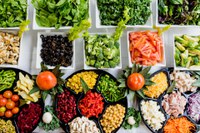Prairie Fare: Try a Salad Buffet
(Click an image below to view a high-resolution image that can be downloaded)
By Julie Garden-Robinson, Food and Nutrition Specialist
NDSU Extension
“We are having main-dish salads for dinner,” I said. “It will be good.”
“I am going to eat my leftovers,” my older daughter announced.
“Did Mom make something healthy?” my husband asked.
I usually make healthful food, I thought to myself.
“I want to eat my leftovers,” my daughter continued.
“Your food will be fine if you eat it tomorrow,” I said. “Trust me on this one.”
I almost said “end of discussion” but I think they figured that out.
I was sauteeing chicken strips and I had plates, mixed greens, thinly sliced apples, croutons, shredded cheese and various salad dressings lined up on the counter.
Homemade focaccia bread with dried herbs sprinkled on top was almost ready to come out of the oven. I thought our kitchen had an inviting aroma.
My daughter wasn’t sold on salad as a main course, but she relented.
“I’m getting more salad,” my husband added.
“The chicken was really good,” my daughter noted.
That’s a start, anyway.
Many of us shortchange ourselves on vegetables and fruits.
Fruits and vegetables are an important part of a healthful diet. They provide fiber, vitamins A and C, and minerals such as potassium to maintain health. They also provide a variety of “phytochemicals” (natural plant chemicals) linked with health benefits.
Eating enough fruits and vegetables may help prevent chronic diseases such as heart disease, Type II diabetes and cancer.
Aim to have a variety of fruits and vegetables in your daily diet. Different colors of fruits and vegetables provide different nutrients. When possible, consume unpeeled fruits or vegetables (such as apples) to maximize the health benefits.
Most of us need 4 or 5 cups of fruits and vegetables to meet our daily recommendation.
As we see colorful grass and flowering plants burst into bloom later this spring, take a cue from nature. Try to eat a wide range of colorful fruits and vegetables. Red, orange, yellow, green, blue and purple vegetables have various health benefits.
Anthocyanins, found in many red, blue and purple fruits and vegetables, are powerful antioxidants that may reduce our risk for some chronic diseases. Lycopene, the red pigment in tomatoes and watermelon, is linked to a reduced risk for certain types of cancer.
Dark green and orange vegetables provide a variety of phytochemicals that our bodies need to keep us healthy. They provide carotenoids that our bodies use to keep our eyes, skin and mucous membranes healthy.
Instead of a recipe, here are some ideas to create a salad buffet of your own. It can be simple, like my example, or as elaborate as you would like.
Check out our “garden to table” publications at https://www.ag.ndsu.edu/food/food-preparation to learn how to grow many vegetables and fruits. Later this summer, you could have a home-grown salad buffet.
A Recipe for a Salad Buffet
- Rinse and prepare a variety of leafy green vegetables. Allow 1 cup of leafy green vegetables per serving to serve as the base of the salad. Examples include chopped fresh cabbage, kale, romaine lettuce, spinach or spring mix.
- Rinse and prepare a variety of vegetables. For each serving, allow 1/2 cup of vegetables for texture, flavor and nutrition. Try some fresh or roasted chopped broccoli, carrots, mushrooms, radish, tomatoes or beets to add flavor and color.
Try this tip: Enhance the flavor by roasting vegetables in a 400 F oven with olive oil and desired seasonings before adding them to your salad.
- Add one or more fruits to your buffet. For each serving, allow 1/2 cup of fruit to add fiber, additional nutrients and a touch of sweetness. Add some chopped fresh apple, fresh blueberries, grapes, mango or orange slices.
- Make grain foods available, if desired. For each serving, allow 1/2 cup of cooked and cooled grain of choice to balance the flavor. Consider cooked pearled barley, brown rice, couscous or quinoa for a change of pace.
Tip: Add quinoa to your salad creation to increase fiber and protein content for an extra-satisfying salad.
- Prepare some protein-rich foods. Allow 1/2 cup of protein per serving. Try adding slices of leftover grilled chicken or steak, roasted ham, cooked eggs, black beans or other canned or cooked beans, tuna or lentils.
Try this tip: Use lean meats and trim away extra fat for optimal nutrition. Be sure to cook meat to a safe internal cooking temperature.
- Choose one or more toppings. Toppings enhance flavor, interest and nutrition in your salad creation. Add about 1 tablespoon of each desired topping per serving. Examples include crumbled blue cheese, plain croutons, dried cranberries, nuts such as sliced or slivered almonds or chopped walnuts, roasted pumpkin or sunflower seeds.
- Provide salad dressings, either homemade or commercial. For each serving, allow 1 to 2 tablespoons (or to taste) of your dressing of choice per plate. Salad dressings add flavor to your salad and help with nutrient absorption, so don’t be afraid to expand your horizons and try something new.
Tip: Pre-made salad dressings tend to contain excess sodium. Try making your own salad dressing to avoid excess sodium while adding a personalized flavor.
(Julie Garden-Robinson, Ph.D., R.D., L.R.D., is a North Dakota State University Extension food and nutrition specialist and professor in the Department of Health, Nutrition and Exercise Sciences. Follow her on Twitter @jgardenrobinson)
NDSU Agriculture Communication - April 1, 2021
Source: Julie Garden-Robinson, 701-231-7187, julie.garden-robinson@ndsu.edu
Editor: Ellen Crawford, 701-231-5391, ellen.crawford@ndsu.edu




